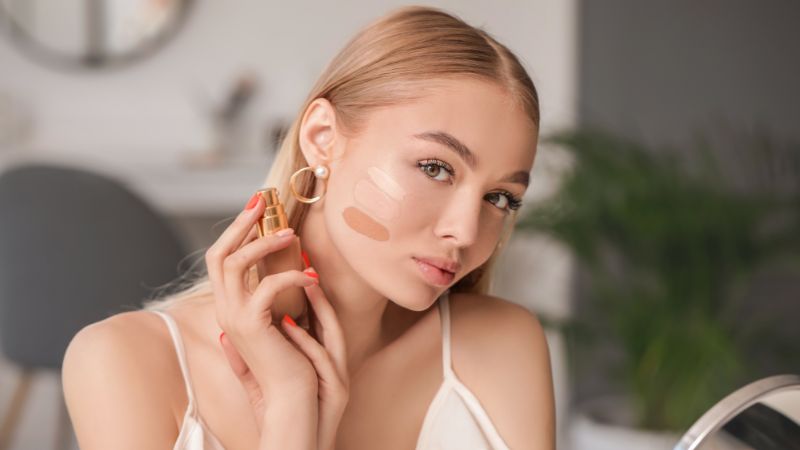
Foundation is the literal base of your makeup routine—it sets the tone for your entire look. Whether you’re after a dewy, natural finish or full glam coverage, the right foundation can make or break your application. But with so many types, shades, and formulas, choosing the right one can feel like navigating a maze.
In this comprehensive guide, we’ll break down everything you need to know about foundation—from understanding your skin type and undertone to selecting formulas that meet your needs and enhance your features. Let’s decode the base layer that makes it all come together.
Why Foundation Matters
Foundation doesn’t just cover imperfections—it unifies skin tone, smooths texture, and creates a clean canvas for the rest of your makeup. The best foundation should feel like a second skin: breathable, weightless, and natural-looking, whether sheer or full coverage.
A good foundation:
- Evens out skin tone and discoloration
- Minimizes the appearance of pores
- Helps makeup adhere better and last longer
- Can offer skincare benefits (hydration, SPF, anti-aging)
Step 1: Know Your Skin Type
Your skin type plays a huge role in choosing the right foundation formula:
Oily Skin
Look for matte, oil-free, or powder foundations that help control shine and reduce excess sebum.
🧴 Try: Long-Wear Matte Liquid Foundation with Niacinamide
Dry Skin
Go for hydrating, dewy, or cream-based formulas rich in humectants like hyaluronic acid or squalane.
🧴 Try: Moisture-Infused Serum Foundation with Squalane
Combination Skin
Use lightweight, oil-balancing formulas or apply a mix—matte on the T-zone and hydrating on the cheeks.
🧴 Try: Adaptive Liquid Foundation with Balancing Complex
Sensitive Skin
Choose fragrance-free, dermatologist-tested, and minimal-ingredient formulas.
🧴 Try: Hypoallergenic Mineral Foundation Stick with Aloe
Mature Skin
Look for foundations with light-reflecting pigments and skincare ingredients like peptides or ceramides. Avoid heavy mattes that settle into fine lines.
🧴 Try: Skin-Smoothing Foundation with Collagen Boost Complex
Step 2: Understand Your Undertone
Your undertone is the subtle hue beneath your skin’s surface. It doesn’t change with sun exposure, and getting it right ensures your foundation blends seamlessly.
- Cool undertones: Pink, red, or blue hues
- Warm undertones: Yellow, golden, or peachy hues
- Neutral undertones: A mix of both
Pro Tip: Check your veins—blue/purple = cool, green = warm, can’t tell = neutral.
🧴 Try Shades Like:
- Cool: Porcelain Rose, Cool Beige
- Warm: Golden Sand, Honey
- Neutral: Nude, Natural Beige
Step 3: Choose Your Desired Coverage Level
Sheer Coverage
- Evens tone while letting skin shine through
- Ideal for minimal makeup looks
- Typically found in tinted moisturizers or serum foundations
Medium Coverage
- Covers mild imperfections while maintaining a natural finish
- Great for daily wear
Full Coverage
- Conceals acne, redness, hyperpigmentation
- Popular in event or glam makeup routines
🧴 Try: Buildable Coverage Foundations with Peptides + SPF for day-to-night versatility
Step 4: Choose the Right Finish
Matte Finish
- Oil-controlling, great for long wear
- Best for oily or combination skin
Dewy Finish
- Radiant, hydrated glow
- Best for dry or mature skin
Natural/Satin Finish
- Balanced—not too matte or too glowy
- Ideal for most skin types
🧴 Try: Light-Reflecting Liquid Base with Vitamin C for a healthy, satin sheen
Step 5: Picking the Right Format
- Liquid Foundation: Versatile, buildable, suitable for most skin types
- Powder Foundation: Lightweight, good for oily skin, quick touch-ups
- Stick Foundation: Convenient, travel-friendly, offers more control
- Cream Foundation: Rich and moisturizing, best for dry or mature skin
- Cushion Foundation: Lightweight, great for reapplication
🧴 Try: Dual-Purpose Compact Cream Foundation with SPF
How to Apply Foundation Like a Pro
1. Start with Clean, Prepped Skin
Apply a moisturizer and a primer suited to your skin type.
2. Use the Right Tool
- Sponge: Natural finish, great for blending
- Brush: More coverage, ideal for liquid and cream
- Fingers: Good for warmth-driven blending of lightweight formulas
3. Blend from Center Outward
Apply foundation to the center of your face and blend outward for the most natural result.
4. Set Strategically
Use powder only where needed—usually the T-zone—to maintain a skin-like finish.
🧴 Try: Micro-Fine Setting Powder with Oil Control Minerals
Foundation Mistakes to Avoid
- Wearing the wrong undertone: Can make your skin look gray or orange
- Not blending into the jawline/neck: Creates a mask effect
- Overapplying product: Less is more—build coverage only where needed
- Skipping primer or prep: Reduces wear time and creates texture
FAQs: Foundation Fundamentals
How do I know my foundation shade?
Test along your jawline or neck in natural light. The best match should disappear into your skin.
Should I use different foundations in summer and winter?
Yes, skin tones can shift slightly with sun exposure and seasonal dryness/oiliness.
Is SPF in foundation enough?
No—while helpful, SPF in foundation is not a substitute for broad-spectrum sunscreen.
What foundation is best for acne-prone skin?
Non-comedogenic, oil-free formulas with calming ingredients like niacinamide or salicylic acid.
Can I mix foundations?
Absolutely! Mixing shades or formulas is a great way to customize coverage, finish, or tone.
Related Reads
- Makeup 101: Your Ultimate Guide to Products, Techniques & Skin Compatibility
- Best Lipsticks for Every Skin Tone: Find Your Perfect Match
- Eye Makeup Essentials: From Natural to Glam
- The Ultimate Guide to Mascara: Volumizing, Lengthening & More
Conclusion: Build Your Base with Confidence
The right foundation does more than cover—it elevates your entire look while supporting your skin’s needs. Whether you’re aiming for no-makeup makeup or flawless glam, foundation helps you control the narrative of your complexion.
Start by understanding your skin type, undertone, and desired coverage. From there, select a format and formula that matches your lifestyle. Don’t be afraid to test, mix, and adapt—your perfect base is out there.
With premium foundations enriched with skin-loving ingredients like peptides, hyaluronic acid, and botanical oils, you’re not just painting a canvas—you’re caring for it too.
